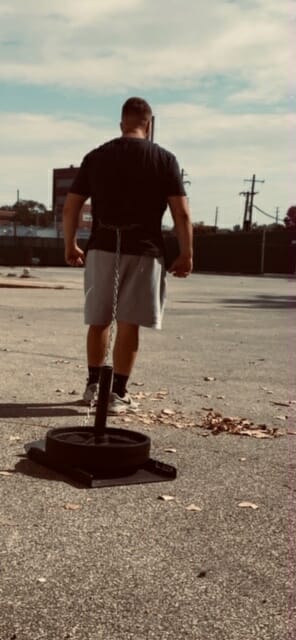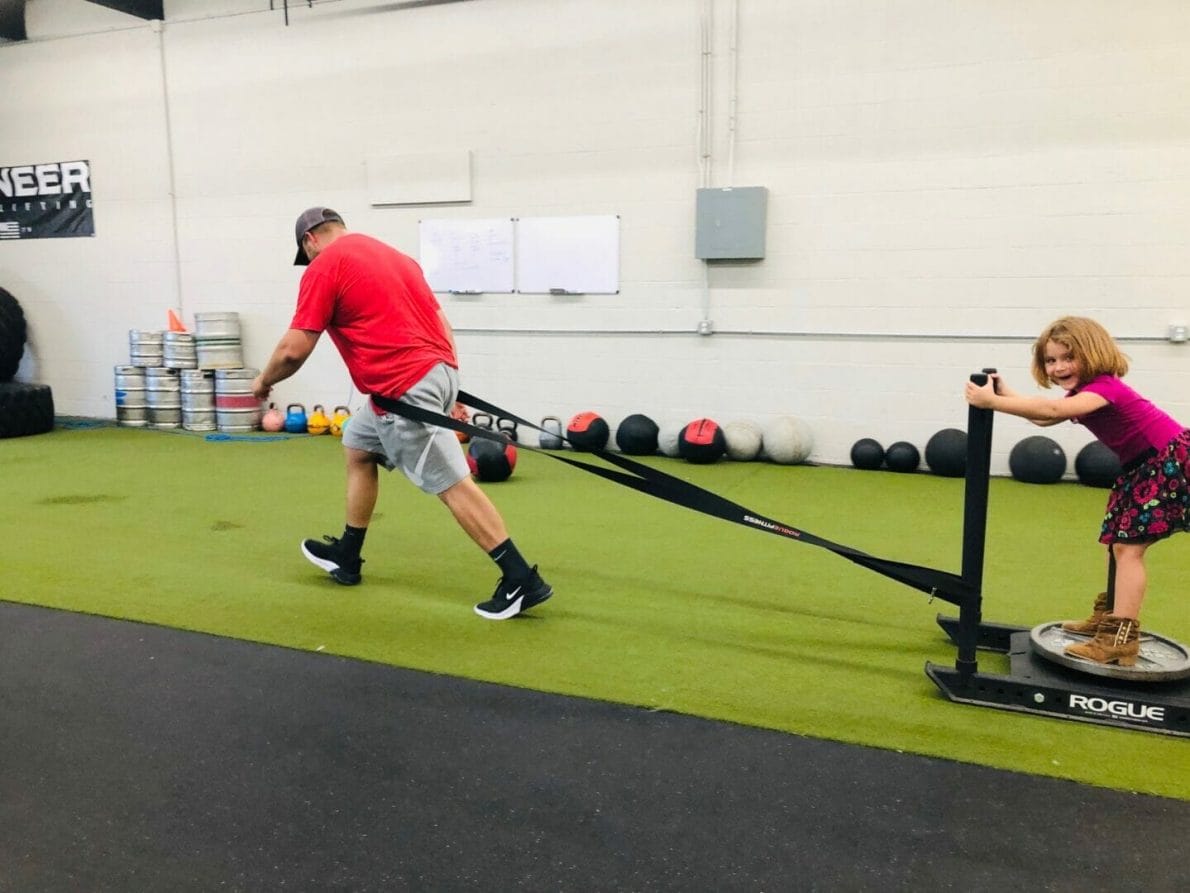The sled is an interesting, versatile piece of equipment. We use it a lot at Brentwood Barbell. Today I thought I’d highlight some of the whys and hows.
Sled Training: Why?
First, I’m going to include all variations of sleds into the category of “sled” for the purpose of this article. Some folks would adamantly argue the differences between sled work and prowler work. We’re just going to keep this simple and assume it’s all the same.
Reason #1: You can’t mess it up
We spend a lot of time educating our athletes on how to move well with a heavy barbell. As such, a lot of mental energy is spent on the platform. It’s nice to be able to finish a workout with something less mentally taxing.
Another valuable fact here is that the sled makes you tired. And being tired during a highly complicated movement (I see you CF) isn’t always the best idea. It’s not necessarily wrong, it’s just that the risk / reward analysis really needs to be gone through. You have to ask yourself, “if I can get the desired stimulus in an inherently less risky way, shouldn’t I”?
Reason #2: It’s easy on the joints but hard on the lungs
I usually tell folks that our gym is a bit “older”. Our members range from 9 to 88 (that’s the real range BTW) but the vast majority of folks working with us are more like 30 to 60. As such, it’s really important to us that we are able to train folks to get the results they want AND not beat the s**t out of them in the process.
Any fool can beat up a client, get them sweaty, and leave them in a pile on the floor. That’s not hard to do (or particularly intelligent). A good coach can guide the athlete toward his/her goals in a way that works WITH the athlete’s available resources (time, energy, recoverability, current fitness, etc.). This is much more complicated and nuanced.
We have found that the sled is very forgiving on knees, backs, and shoulders. In fact, we often use it in “rehab” programming for things like low back pain and knee pain. We’ll discuss more on this later.
With all this talk of the sled being easy on the joints, you might think that you can’t get a great metabolic or conditioning stimulus. You would be wrong. So wrong. If it’s your limits you seek, the sled shall help you find them!
Below we’ll get into some details about conditioning possibilities but for now, don’t be fooled by the accessibility of this tool.
Reason #3: The Sled is Cost Effective
You can buy a great sled for <$100. As a gym owner, that’s important to me. We can buy 4-5 sleds per 1 fan bike. Fan bikes are great too, but you just can’t beat the value per dollar when it comes to the sled.
If you don’t want to buy a sled, you can also make one with an old tire and a rope.
Sled Training: How?
Let’s look at a few examples.
Option #1: Cardiac Output Method
For this type of programming, we are simply wanting the athlete to move continuously at a sustainable pace (say 6-7/10 effort). The point of the cardiac method is sustainability. This type of exercise improves the heart’s ability to deliver blood / nutrients to the rest of the body (based on HR and stroke volume). Here are some practical benefits to this type of work:
- great for building an endurance base for beginners / deconditioned folks
- great for rehab programming
- great for recovery between hard lifting sessions
- great for improving sleep / stress reduction
Sample Week
| Monday | Tuesday | Wednesday | Friday | Saturday |
| Box Squat 3×1@9 Bench 3×10@80% Pull Down 8-12 x 3@8 Step Up 8-12 x leg x 3@8 DB Floor Press 8-12 x 3 @8 | Conditioning x 45 min – 15 min reverse sled drag @50lbs – 15 min lateral sled drag @ 50lbs – 15 min sled drag @50lbs | Deadlift 1×10@70% Press 4×4 @8 Dips 8-12 x 3@8 EZ Bar Curl 8-12 x 3@8 Back Raise 25 x 2 @8 | Pin Bench 3×1@9 Squat 2×10@75% Chin Up x 5m AMRAP Inc DB Bench 8-12 x 3@8 Belt Squat 8-12 x 3@8 | Conditioning x 45 min – 15 min reverse sled drag @50lbs – 15 min lateral sled drag @ 50lbs – 15 min sled drag @50lbs |
Option #2: Aerobic Intervals
For this workout, we are wanting the athlete to work at an effort that requires some rest. It’s not an all-out effort necessarily, but it’s more challenging than the cardiac output method previously discussed. We usually want anywhere from a 1:1 to a 1:3 work to rest ratio.
In our example below, we have opted to keep our CO work early in the week and save the more intense (interval) work for the weekend (the athlete would have Sunday to fully recover).
Sample Week
| Monday | Tuesday | Wednesday | Friday | Saturday |
| Box Squat 3×1@9 Bench 3×10@80% Pull Down 8-12 x 3@8 Step Up 8-12 x leg x 3@8 DB Floor Press 8-12 x 3 @8 | Conditioning x 45 min – 15 min reverse sled drag @50lbs – 15 min lateral sled drag @ 50lbs – 15 min sled drag @50lbs | Deadlift 1×10@70% Press 4×4 @8 Dips 8-12 x 3@8 EZ Bar Curl 8-12 x 3@8 Back Raise 25 x 2 @8 | Pin Bench 3×1@9 Squat 2×10@75% Chin Up x 5m AMRAP Inc DB Bench 8-12 x 3@8 Belt Squat 8-12 x 3@8 | Conditioning 20 min – heavy sled push x 30s – rest x 90 sec – 10 total rounds |

Option #3: Mixed Modality Intervals
The first couple of workouts are great but folks will often say they’re a bit boring or repetitive. Yes, they can be but this is where you have to be honest about your primary goal. If you have an upcoming powerlifting meet, then tossing in some strongman conditioning 2x per week might not be the best way to achieve your desired results.
But what if you just want to be jacked, strong, and well conditioned so you can strut around the pool? I’m glad you asked 🙂
Because your goal(s) are rather general, we can really vary up the training and be less concerned about specific strength gains. In a sense, we’re looking at a more well-rounded final product vs. being better at a single component of fitness (strength in this case).
For our mixed modality example, we’re going to use some “strongman” exercises in addition to the sled.
Sample Week
| Monday | Tuesday | Wednesday | Friday | Saturday |
| Box Squat 3×1@9 Bench 3×10@80% Pull Down 8-12 x 3@8 Step Up 8-12 x leg x 3@8 DB Floor Press 8-12 x 3 @8 | Conditioning x 45 min – 15 min reverse sled drag @50lbs – 15 min lateral sled drag @ 50lbs – 15 min sled drag @50lbs | Deadlift 1×10@70% Press 4×4 @8 Dips 8-12 x 3@8 EZ Bar Curl 8-12 x 3@8 Back Raise 25 x 2 @8 | Pin Bench 3×1@9 Squat 2×10@75% Chin Up x 5m AMRAP Inc DB Bench 8-12 x 3@8 Belt Squat 8-12 x 3@8 | Conditioning x 4 rounds (30m cap) – sled push x 100′ – stone load x 5 – med ball carry x 100′ – fan bike x 20 calories – rest 3m |
These are just a few examples of how the sled be used in your training. The athlete and coach are really only limited by their creativity and planning.

Want to learn more about how we program and coach our athletes? Book a Meeting and we’ll put our heads together to come up with a plan to help you reach your goals!
Talk soon,
James

